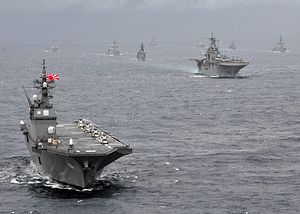Japan’s ruling Liberal Democratic Party is gearing up to push the right to collective self-defense through the cabinet this week. On Wednesday the party’s vice president, Masahiko Komura, said he will work with junior coalition partner New Komeito, according to the Japan Times, “so that the decision will be reflected in the Japan-U.S. defense guidelines revised by the end of this year. Talks are expected to begin next week.”
The LDP wants the coalition to be in total agreement before the Cabinet gives its approval. Prime Minister Shinzo Abe will provide an outline Thursday, based on a report from a panel chosen by him, that explains the government’s stance on collective self-defense. The LDP and New Komeito will meet next Tuesday to discuss Abe’s proposal.
Abe’s panel is expected to propose six conditions for exercising collective self-defense: three are conditional and three are procedural. The conditional requirements include: 1) A close Japanese ally is under attack; 2) A grave threat to Japanese security exists if force is withheld; and 3) Another country under attack asks Japan for offensive military assistance. The procedural requirements are: 1) The prime minister decides to use force; 2) The Diet approves the prime minister’s decision; and 3) A third country grants Japan permission to move troops through its territory en route to a conflict.
There are two different sides to this new interpretation, and each coalition partner has a different opinion on which side is more important. While the LDP would like these six new conditions to be the basis for the Cabinet’s proposal on collective self-defense, New Komeito first wants to focus on “grey zone” situations regarding Self-Defense Forces deployment. This includes clarifying existing laws that grant no provision for deploying SDF forces in case of an incident, such as Chinese vessels violating Japanese territorial waters near the disputed Senkaku/Diaoyu Islands. Current law does not stipulate how SDF forces can forcibly remove Chinese vessels in such a situation.
Given the stances of the two coalition partners, it is hard to see a consensus forming on this issue. New Komeito simply wants to clarify existing procedures so that Japanese forces will have a clear protocol for engagement. The LDP is seeking to expand the confines within the Japanese constitution, without an outright change to Article 9, which essentially guarantees Japan’s passivity.
New Komeito has historically been against the type of changes that the LDP is spelling out in its new proposal. The LDP has assured New Komeito that the “grey zone” issue will be addressed first next week. However, New Komeito is very much a junior partner in every sense of the term, given that the LDP holds an outright parliamentary majority without its smaller partner. It remains to be seen what kind of pressure the LDP can and will bring to bear in order to push forward with one of Abe’s flagship policies.
The LDP is indeed being very careful with how it pursues collective self-defense and lets the proposal play out, first in the cabinet and then in the Diet. It wants total unanimity within the Cabinet before it pursues debate in the Diet; a completely united front on the part of the government will be required to cause the first cracks in Japan’s pacifist society as enshrined in its constitution.
According to Reuters, the path as the LDP sees it, is to “embody the change in a cabinet resolution next month, before the parliamentary session ends on June 22, or at the latest by September, to leave time to revise a slew of related laws in an extra session of parliament late in the year.” If that can be settled, then the government would have the new collective self-defense proposal included in the update to Japan-U.S. defense guidelines that could be finished as early as the end of this year.
That timetable is of course a best-case scenario for the LDP, and one that will likely face resistance both at home and abroad. An even greater likelihood is that events in the region will dictate the LDP’s ability to make this happen. The Abe government has missed no opportunity to tie China’s oil rig incident with Vietnam and seizure of a Chinese fishing boat by the Philippines to Japan’s own security interests. Events in the South China Sea, over which China has significant influence, may unwittingly allow Abe’s proposal to stay on target.

































